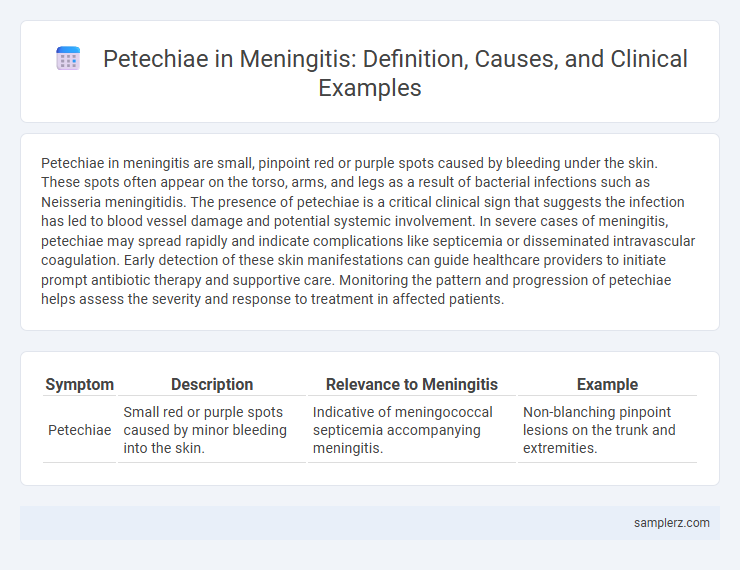Petechiae in meningitis are small, pinpoint red or purple spots caused by bleeding under the skin. These spots often appear on the torso, arms, and legs as a result of bacterial infections such as Neisseria meningitidis. The presence of petechiae is a critical clinical sign that suggests the infection has led to blood vessel damage and potential systemic involvement. In severe cases of meningitis, petechiae may spread rapidly and indicate complications like septicemia or disseminated intravascular coagulation. Early detection of these skin manifestations can guide healthcare providers to initiate prompt antibiotic therapy and supportive care. Monitoring the pattern and progression of petechiae helps assess the severity and response to treatment in affected patients.
Table of Comparison
| Symptom | Description | Relevance to Meningitis | Example |
|---|---|---|---|
| Petechiae | Small red or purple spots caused by minor bleeding into the skin. | Indicative of meningococcal septicemia accompanying meningitis. | Non-blanching pinpoint lesions on the trunk and extremities. |
Recognizing Petechiae: Early Signs of Meningitis
Petechiae are small, red or purple spots caused by capillary bleeding under the skin, often appearing as an early sign of meningitis. These pinpoint hemorrhages commonly appear on the torso, arms, and legs and do not blanch when pressed, making them a critical diagnostic indicator. Timely recognition of petechiae can lead to faster meningitis diagnosis, enabling urgent medical intervention to prevent severe complications.
What Do Petechiae Look Like in Meningitis?
Petechiae in meningitis appear as small, pinpoint red or purple spots on the skin, caused by minor bleeding from broken capillaries. These spots do not blanch under pressure and often cluster on the trunk, limbs, or mucous membranes. The presence of petechiae alongside symptoms such as fever, neck stiffness, and headache can indicate meningococcal meningitis, requiring immediate medical attention.
Common Locations of Petechial Rash in Meningitis
Petechial rash in meningitis commonly appears on the trunk, lower extremities, and mucous membranes due to small vessel bleeding triggered by bacterial endotoxins. These pinpoint, non-blanching red or purple spots often concentrate around the chest and legs, reflecting the systemic vascular response to infection. Early recognition of petechiae in these locations is critical for prompt diagnosis and treatment of meningococcal meningitis.
Progression of Petechiae During Meningitis Infection
Petechiae in meningitis typically start as small, pinpoint red or purple spots caused by capillary bleeding due to bacterial endotoxins and inflammatory response. These lesions can rapidly increase in size and number within hours, indicating worsening vascular damage and disease severity. Monitoring the progression of petechiae is critical for early diagnosis and prompt treatment to prevent complications such as septicemia and disseminated intravascular coagulation.
Differentiating Petechiae from Other Skin Rashes
Petechiae in meningitis typically present as small, pinpoint, non-blanching red or purple spots caused by capillary bleeding under the skin, often concentrated on the trunk and lower extremities. Differentiating petechiae from other skin rashes involves assessing characteristics such as size, distribution, and blanching response--petechiae do not fade when pressed, unlike erythematous rashes in viral infections. Prompt recognition of petechiae alongside symptoms like fever and neck stiffness is critical for early diagnosis and treatment of bacterial meningitis.
When Petechiae Signal a Medical Emergency in Meningitis
Petechiae in meningitis often present as small, red or purple spots on the skin caused by capillary bleeding and signal a potential medical emergency when they appear rapidly and spread widely. These pinpoint hemorrhages indicate vascular damage from bacterial infection, warranting immediate hospitalization and antibiotic treatment to prevent severe complications or death. Recognizing petechiae alongside symptoms like fever, neck stiffness, and altered mental status is critical for early diagnosis and timely intervention in meningococcal meningitis.
Petechial Rash vs. Other Meningitis Symptoms
Petechial rash in meningitis presents as small, pinpoint red or purple spots caused by bleeding under the skin, often indicating a severe bacterial infection such as meningococcal meningitis. Unlike common meningitis symptoms like fever, headache, and neck stiffness, the petechial rash specifically signals vascular damage and requires immediate medical attention. Recognizing this rash alongside neurological signs improves early diagnosis and treatment outcomes in meningitis cases.
Case Studies: Petechiae in Meningococcal Meningitis
Case studies reveal that petechiae, small red or purple spots caused by capillary bleeding, are a common early dermatological sign in meningococcal meningitis. In documented cases, patients with Neisseria meningitidis infections often present petechial rashes primarily on the trunk and lower extremities, indicating systemic endothelial damage. Early recognition of these petechiae facilitates prompt diagnosis and treatment, reducing the risk of severe complications such as septicemia and disseminated intravascular coagulation.
Diagnosing Meningitis through Petechial Appearance
Petechiae in meningitis typically present as small, non-blanching red or purple spots on the skin, signaling capillary hemorrhages caused by bacterial infection. The presence of petechial rash alongside symptoms such as fever, headache, and neck stiffness significantly aids in diagnosing meningococcal meningitis. Identifying petechiae early during clinical examination is crucial for prompt laboratory tests, including cerebrospinal fluid analysis, to confirm meningitis and initiate appropriate antibiotic therapy.
Immediate Actions to Take if Petechiae are Observed
Petechiae in meningitis appear as small, red or purple spots caused by bleeding under the skin and require immediate medical attention to prevent rapid progression to severe infection. Upon observing petechiae, call emergency services and ensure the patient remains calm and immobile to reduce the risk of spreading infection or shock. Administering oxygen and preparing for possible intravenous antibiotics can be critical while awaiting professional healthcare intervention.

example of petechia in meningitis Infographic
 samplerz.com
samplerz.com